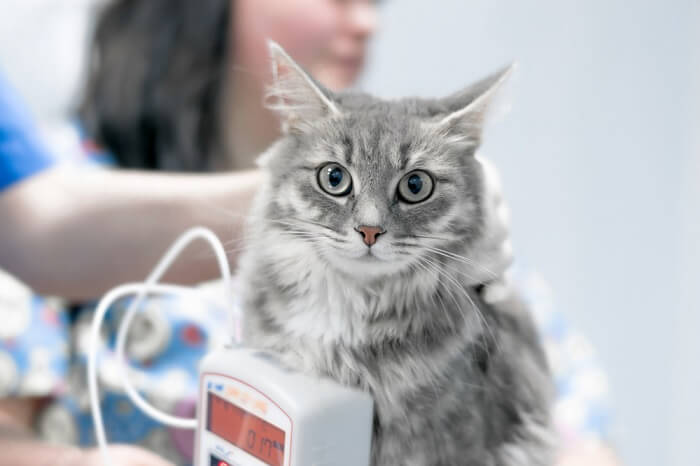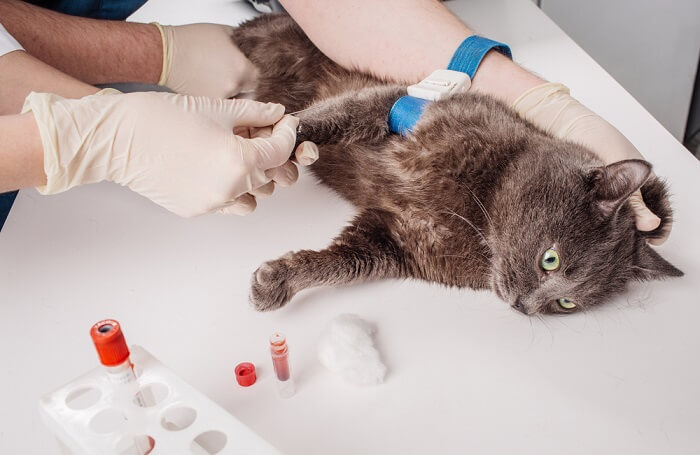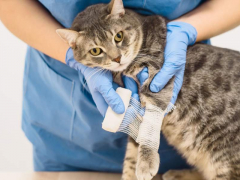
DinaSova / Shutterstock.com
When you visit the office of your local DVM veterinarian, there are many times when you may be offered blood work for your cat.
The aim of this article is to explain why blood work may be recommended, what sort of costs may be involved, and what sort of levels of different blood parameters are normal. Urinalysis is often carried out at the same time as bloodwork, but that is a topic for a different article.
Cat blood tests should never be instigated by a lay person: this should always be requested by a veterinarian after a careful professional analysis of a cat’s health. There should always be a valid clinical rationale behind the decision to carry out blood work.
Reasons a Cat May Need Blood Tests
A healthy cat’s first visit to the vet. Sometimes, it can be useful to carry out a one-off basic screen to carry out a detailed analysis of the internal metabolism of a cat.
This allows any hidden underlying issues to be identified (e.g. congenital abnormalities such as liver or kidney disease), it allows screening to take place for infectious diseases (such as FIV or FeLV) and it establishes a baseline which can be used to compare blood test results later in a cat’s life.
- Regular wellness checks. Many veterinarians recommend routine health checks, every six or twelve months. As well as examining your cat carefully, blood tests may be suggested as a way of confirming that there are no hidden issues developing. Urine tests may also be recommended. Routine wellness exams are especially important for senior cats. Early detection of abnormalities in organ function can be key to identifying health conditions at an early stage, so that prompt, more effective treatment can be given.
- Pre-surgery visits. When an intervention involving anaesthesia or surgery is planned, it makes sense to be double-sure that a cat is as healthy as they appear to be. For this reason, pre-operative blood tests are often recommended, to screen a cat’s internal metabolism for any abnormalities. If there are abnormal parameters, a procedure may then sometimes be deferred.
- Sick cats. When a cat falls ill for any reason, blood work is often recommended as a key way of searching for any signs of illness of the various internal systems. This is when it can be useful to have baseline values for a cat, so that any abnormalities can be recognised as new, and therefore more likely to be significant. Investigation of life threatening illnesses nearly always includes detailed blood work.
How Often Do Cats Need Blood Tests?
The answer to this question depends on the cat: a healthy young cat may not need to have blood tests repeated for several years, while a sick elderly cat may need to have a blood test every month. Your veterinarian will guide you on making the decision as to how often blood tests should be taken.
How Much Do Blood Tests Cost?
The cost of feline bloodwork varies hugely, depending on what precise tests are being undertaken. A simple test might cost $20 while a battery of detailed, complex tests could cost $400. It’s best to discuss the price of any proposed tests beforehand, so that you know what to expect.
What Does Blood Testing Do?
Blood tests measure the constituents of a cat’s blood, including cells, hormones and chemicals, to gain a better understanding of the cat’s health.
Blood sample volumes vary, but usually, an amount between 0.5ml and 2.5ml is sufficient to carry out all necessary tests. This is one small syringeful of blood, or less than half a teaspoonful.
How Are Blood Samples Taken?

Close-up of Annie the cat having blood drawn for her wellness screening. Chris Vanderhoof / Cats.com
There are three common ways of collecting a blood sample from a cat. Generally, the cat is simply held quietly and gently; sometimes, a towel may be used to help with restraint, to prevent the cat from biting or using its claws to scratch.
- Cephalic vein. This is the most common location: a small amount of fur is clipped off one of the front legs, just below the elbow. A technician then gently restrains the cat, placing their thumb and forefinger around the leg at the level of the elbow. This action blocks the return of blood from the limb to the heart, causing the cephalic vein to swell and become visible. The veterinarian then uses a syringe and needle to draw blood out of the vein.
- Jugular vein. Sometimes, especially if a larger volume of blood is needed, the jugular vein, in the neck, is used. Again, fur is clipped over the vein (on one side of the neck), and a technician restrains the cat gently, holding both feet in one hand, and using the other hand to lift the cat’s chin up, exposing the neck. The veterinarian then raises the vein by placing one finger on the lower part of the neck before using a syringe and needle to collect the blood sample from the vein.
- Saphenous vein. Sometimes, the hind leg will be used to collect a blood sample. As with the foreleg, fur is clipped off the lower leg, an assistant holds the leg to raise the vein, and the veterinarian collects the sample.
Types of Bloodwork for Cats
There are many different possible blood tests that may be carried out, but the main ones are summarised below. Often, simple blood tests can be carried out “in-house” in the house laboratory of the veterinarian’s office, while other more complex tests may need to be sent on to an external laboratory.
Virus Tests
Two common viruses, Feline Leukemia (FeLV) and Feline Immunodeficiency Virus (FIV) can cause serious illness and can be ruled in or out via a simple blood test. It’s less common to test for other viruses but your veterinarian may have specific reasons if this is ever suggested.
Hematology or Complete Blood Count (CBC)
This test involves counting the various different cells in the bloodstream, including red blood cells, platelets, and the various different types of white blood cells.
Changes in the cell counts give useful information about a cat’s immune system, with changes seen if there is inflammation, toxicity, blood clotting disorders or many other disease processes in the cat’s body.
Some other measurements may be made, such as the hemoglobin level in the blood, which can be very important in some conditions such as anemia.
A particular measurement called the Packed Cell Volume (PCV) indicates the total amount of solid cells compared to liquid (serum) in the blood sample, and this is a useful guide to conditions such as dehydration or anemia.
Biochemistry Including Hormone Measurements

A list of conditiones that can be diagnosed by blood tests is vast, and some of them are diabetes, liver and kidney disease as well as hormonal imbalance. PRESSLAB / Shutterstock.com
Generally, a wide panel of chemicals in the cat’s blood is analysed. The levels of these chemicals are usually kept within narrow parameters in a healthy cat’s bloodstream. Elevated – or reduced – blood levels often give a strong hint about the nature of the underlying disease process.
From diabetes to liver and kidney disease, there is a long list of conditions that can be diagnosed by blood tests. Tests to measure hormones are also available, although the only commonly measured hormone routinely is Total T4, or thyroxine: elevated levels are diagnostic for hyperthyroidism, a common condition affecting mostly older cats.
The commonly measured blood tests measured in a typical screening sample are listed below.
- Albumin (ALB): This is one of the serum proteins (the other is Globulin), with levels useful for assessing hydration and hemorrhage, as well as for evaluating the function of the intestines. liver, and kidneys.
- Alkaline phosphatase (ALKP): Elevations of this enzyme are suggestive of liver disease, gall bladder disease, and pancreatic disease. Elevated normals can be normal in young cats, stimulated by active bone growth.
- Alanine aminotransferase (ALT): Raised levels are suggestive of damage to liver cells, although the precise cause of the damage cannot be determined: a liver biopsy may be needed for this evaluation.
- Aspartate aminotransferase (AST): Increased levels suggest liver, heart, or skeletal muscle damage.
- Blood urea nitrogen (BUN): Increased levels are suggestive of kidney disease, but other causes are possible, and reduced levels can indicate liver disease.
- Calcium (Ca): Changes in the level of this mineral can be caused by many different diseases, from kidney disease to hormonal diseases to some types of cancer.
- Cholesterol: elevated levels of cholesterol may be seen in a range of hormonal and other diseases.
- Chloride (Cl): Chloride is a so-called “electrolyte”( a substance that conducts electricity when dissolved in water). Levels are reduced in conditions like vomiting and raised when a cat is dehydrated.
- Creatinine (CREA): Increased levels are suggestive of kidney disease. The pattern of BUN and CREA together is used to gainer a better understanding of kidney function than either parameter on its own. Urea tends to be a breakdown product of protein from the food, while Creatinine tends to reflect protein originating from the muscles, so this can be a more reliable indicator in some instances..
- Gamma Glutamyl transferase (GGT): This is an enzyme that is released into the blood when there is damage to the liver, gall bladder, and bile duct.
- Globulin (GLOB): This is the second main blood protein (the other is Albumin). Raised levels suggest chronic inflammation as well as a range of other possibilities.
- Glucose (GLU): Glucose is the main sugar in the blood, with raised levels primarily indicating diabetes mellitus, and reduced levels caused by many conditions, possibly leading to collapse, seizures, or unconsciousness.
- Potassium (K): This is another electrolyte. Like Chloride and Sodium, it can be lost from the body in gastrointestinal disorders such as vomiting and diarrhea, leading to reduced levels.
- Raised levels can suggest kidney failure, dehydration, or obstruction of the urethra, and can lead to a slow heart rate (bradycardia) or even cardiac arrest.
- Sodium (Na): Sodium is another electrolyte, also lost with symptoms following episodes of vomiting and diarrhea, so reduced levels may be seen in these conditions. It’s often linked to hydration status.
- Phosphorus (PHOS): Raised phosphorus levels may be seen in kidney disease, hyperthyroidism, bleeding disorders, as well as other conditions.
- Symmetric dimethylarginine (SDMA): this is a newer test that provides a more sensitive assessment of kidney function. Urea and Crea are only raised when 70% of renal function has been lost, while SDMA tends to be elevated when only 30-50% of kidney function is disrupted.
- Total bilirubin (TBIL): Bilirubin is a yellow pigment that is excreted from the body via the gall bladder passing it in the bile into the digestive tract.
- Raised levels cause jaundice, which may or may not be visible during a physical examination of the animal. The most likely causes are either increased breakdown of red blood cells (haemolytic anaemia) or reduced excretion of pigment in the bile (gall bladder or bile duct disease).
- Total protein: The total protein level is the sum of the albumin and globulin levels: this is often used to assess hydration status, and is useful in assessing the liver kidneys, as well as providing information pertinent to certain infectious diseases.
- Thyroxine (T4): Thyroxine is the main thyroid hormone (also known as the total thyroid level), with raised levels indicating hyperthyroidism in cats.
There are many other specific blood tests that may be recommended when investigating a sick cat. Often, these tests need to carried out by an external commercial laboratory. The best answer is to discuss such tests in detail with your veterinarian, so that you understand precisely what’s being done.
The information listed above will help you to understand the results of feline blood work, but you will need to discuss this in detail with your veterinarian to fully understand the meaning of the various different results.
This is a complex science, and it is not possible for most cat owners to have a full, detailed understanding of the significance of detailed patterns of blood test results.
Conclusion
The interpretation of blood work is a complex science, and advice in this area must be guided by the professional supervision of your veterinarian.
The information in this article is a useful basic briefing on the topic, but for a deeper understanding of precisely what is happening in your own pet, a detailed discussion with the veterinarian treating your cat is essential.







